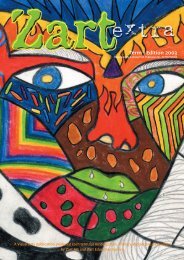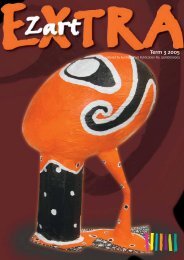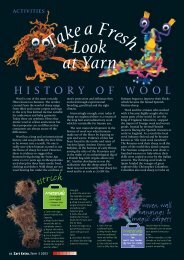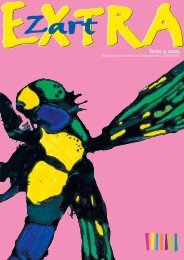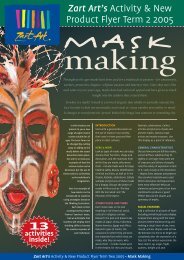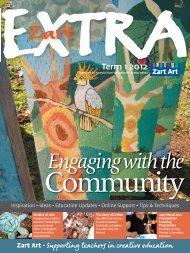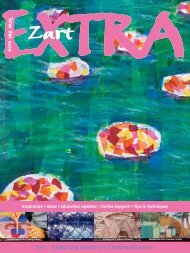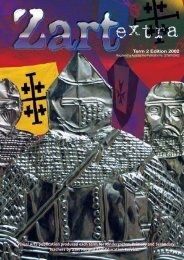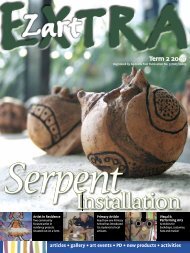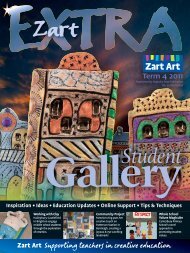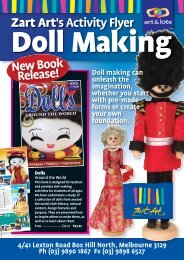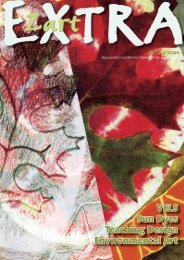Inspired by Ah Xian - Zart Art
Inspired by Ah Xian - Zart Art
Inspired by Ah Xian - Zart Art
You also want an ePaper? Increase the reach of your titles
YUMPU automatically turns print PDFs into web optimized ePapers that Google loves.
Term 4 2008Term 4 2008Registered <strong>by</strong> Australia Post Publication No. 327687/00003Self Identity<strong>Inspired</strong> <strong>by</strong> <strong>Ah</strong> <strong>Xian</strong>Postcard fromBorneo...Bring your travels backto the art room.LearnscapingRead how one school istaking the classroomoutdoors - developingthe grounds as well asattitudes.<strong>Zart</strong> supportsCanTeenWorking together tocreate a healthy andpositive environment.articles • gallery • art events • PD • new products • activities
ContentsNews, Events & Dates . . . . . . 2Secondary <strong>Art</strong>icleHeads . . . . . . . . . . . . . . . . . . . . 3Student Gallery . . . . . . . . . . . 5Primary <strong>Art</strong>icle:Antarctica An <strong>Art</strong> Exploration . 6Profile <strong>Art</strong>icle:Learnscaping our school . . . . 8Term 4 PostcardsBorneo . . . . . . . . . . . . . . . . . . . 9Secondary ProfessionalDevelopment & Tours . . . . . 10New products . . . . . . . . . . . . 11New Resources . . . . . . . . . . . 12• arts• education• eventsEditorJan Roker & Dani Chak<strong>Art</strong> Direction & ProductionBritta PoljansekPhotographyNicole MerkelContributorsEve Close, Julie Lach, Ruth Cronin, Ruth Bode and GayleClarke<strong>Zart</strong> ExtraISSN 1448—8450<strong>Zart</strong> Extra is published quarterly <strong>by</strong> <strong>Zart</strong> Education, a divisionof <strong>Zart</strong> <strong>Art</strong> Pty Ltd. This publication is mailed prior to the firstweek of the term issue date. This newsletter allows artteachers/co-ordinators to learn about what is happening in arteducation and what other art teachers are doing. You will findinformation on new art techniques and processes, the latestmaterials and resources on the market. Please note, all pricesquoted are valid for the duration of the current term only andare subject to change without notice. The insert of thenewsletter provides details of our term's workshops, soteachers can then contact us and book into the workshop.Due to various circumstances some information may besubject to change. <strong>Zart</strong> <strong>Art</strong>, <strong>Zart</strong> Extra logo and masthead areregistered trademarks of <strong>Zart</strong> <strong>Art</strong> Pty Ltd. All content is subjectto copyright and may not be republished without prior consentfrom <strong>Zart</strong> <strong>Art</strong>. All submissions become property of <strong>Zart</strong> <strong>Art</strong>.Submissions may be published in the <strong>Zart</strong> Extra or posted onwww.zartart.com.au the official art education resource. <strong>Zart</strong><strong>Art</strong> reserves the right to edit submitted articles/activities forcontent, length and clarity.<strong>Zart</strong> <strong>Art</strong>Supporting teachers in creative education<strong>Zart</strong> offers an extensive range of fine art materials,resources, craft and technology supplies. You will findcompetitive prices and efficient and quick service.4/41 Lexton Road, Box Hill NorthMelbourne Victoria 3129Ph: (03) 9890 1867 Fax: (03) 9898 6527www.zartart.com.auE: zartart@zartart.com.auAdministration Hours:Monday – Friday: 8.30 am – 5.00 pmCustomer Service Centre:Monday – Wednesday & Friday: 8.30 am – 5.00 pmThursday : 8.30 am – 7.00 pmSaturday: 8.30 am – 2.00 pmEventsJune 2008 - 22nd February 2009: Heide Museum of Modern <strong>Art</strong>Hinterlands Albert Tucker’s Landscapes 1960-1975 28th28th June - 5th October 2008 : Melbourne Winter MasterpiecesNGV International <strong>Art</strong> Deco 1910–1939October 2008 : The Ian Potter Centre Across the desert:Aboriginal Batik from Central AustraliaCanTeen <strong>Art</strong>y OfficeOn Saturday 19th of July, <strong>Zart</strong> <strong>Art</strong>represented <strong>by</strong> Tania Di Berardino,helped transform the CanTeenVictorian Office into a place of fun andcreativity.CanTeen is an Australian Organisationfor Young People Living With Cancer,aged 12-24. Members, volunteers andteam leaders worked together tocreate four creative art piecesthroughout the CanTeen offices inFlemington, Victoria. Each art piecerepresented CanTeen’s values: identity,pride, team work, initiative,inspiration, positivity and celebration.BudgetsIf your school requires your department to finish outstanding budgetmoney <strong>by</strong> a certain time this year, and as yet you have not worked outyour program requirements- <strong>Zart</strong> <strong>Art</strong> can help.We can invoice the remainder of your budget for general art materialsnow, and then provide a product credit, so that you may select youritems as you need them without feeling pressured. Just speak to one ofour customer service people at <strong>Zart</strong>. They will help you with thisprocedure.Catalogue 2009The 2009 <strong>Zart</strong> <strong>Art</strong> Catalogue will bemailed out during the weekcommencing Monday 17thNovember. If you would like to takeadvantage of the Back to SchoolPrices early, we are happy to supplyyour order in the last few weeks ofterm 4, 2008 or January 2009 andinvoice your school account inFebruary 2009.Christmas WinnersAs part of our Christmas programmeeach week <strong>Zart</strong> presents a gift pen setvalued at $50 to 3 lucky teachers whoorder form our Christmas Catalogue.So far congratulations to the followingwinnersRyan Catholic College, QLDBacchus Marsh CollegeSandringham East Primary SchoolMurray Shire Council, NSWSt Cecilias School, Glen Iris, VICMilleara Primary SchoolNeed Inspiration?One of our qualified staff can come to yourschool and help take the pressure off you.We can assist in a whole range of areas withyour art program and show you the latestrange of products and Christmas ideas. <strong>Zart</strong><strong>Art</strong> supports teachers in Creative Educationacross Victoria and Tasmania.Simply email sales@zartart.com.au or callTash Gatto on 03 9890 1867 to make anappointment.2 www.zartart.com.au
Secondary <strong>Art</strong>icleSelf identity;Clay busts inspired <strong>by</strong>the art of <strong>Ah</strong> <strong>Xian</strong>Strathcona Baptist Girls Grammar SchoolStrathcona Baptist Girls GrammarSchool offers <strong>Art</strong> to all year levels.<strong>Art</strong> is a popular subject for girls thatare creative and want to study <strong>Art</strong>safter VCE. The school has justfinished building the muchanticipated Creative and Performing<strong>Art</strong> Centre which will be operationalfrom the end of August.The unit of work on self identitywas developed for a group of Year 10Ceramics students and took placeover approximately 18 practicalsessions (two periods a week) in firstsemester. Theory was studiedseparately from this practical class.The ceramic busts were inspired<strong>by</strong> the work of <strong>Ah</strong> <strong>Xian</strong>, an artistwho was born in Beijing and nowlives in Sydney. I wanted the unitof work to have a very strongtechnical aspect as well as providean opportunity for each student todevelop their own personal skillsand interests. The art of <strong>Ah</strong> <strong>Xian</strong>also provided an excellent topicfor a class discussion on definingthe role of an artist and thedifferences between artist,designer and the artist as director.I began <strong>by</strong> showing the girls arange of images of <strong>Ah</strong> <strong>Xian</strong>’s workand other artists includingUkranian artist Sergei Isupov. Thestudents were asked to designsome imagery that reflected theirself identity. This involved sketchesand scrapbooking into their visualdiaries any useful and relevantimagery, including other artworks.Each head was constructed using arange of techniques, beginning with aheavy slab and then adding coils tobuild up the basic framework. Theslab was formed into a thick, hollowcylinder from which to begin shapingthe shoulders, neck and lower jaw.Using mirrors to reflect their ownfeatures, the girls manipulated the clayto fabricate the contours of the heads.When they began adding the finedetails, the heads gained character andchanged dramatically in a matter ofdays. The girls were able to appreciate<strong>Zart</strong> Extra_Term 4 2008 3
Secondary <strong>Art</strong>icle Cont“Individually and collaborativelystudents explore their own works andworks <strong>by</strong> other artists working indifferent historic and cultural contexts”At a Glance:Order of events- over two terms1. Introduction to <strong>Ah</strong> <strong>Xian</strong> and studentsbegin ceramic bust construction afterdemonstration of techniques.2. Clay construction.3. Group discussion.4. Development of ideas for imagery(throughout the unit, as studentsrevised and altered their ideas).5. Weekly presentation <strong>by</strong> a student ontheir selected topic followed <strong>by</strong> groupparticipation with practical testing ofthe technique and/or material.6. Firing of test samples.7. Gradual completion of busts & trialsfor decorative finish.8. Completion and firing.Some VELS objectives forLevel 6 CeramicsCreating and Making; Buildstrong technical skills in usingclay and decorative techniques;Develop a sound understandingof the materials involved; Createa range of ceramic pieces and trialmultiple techniques; Develop andresolve ideas and artistic concepts;Explore and research using the internetand various other resources;Maintain a visual diary; Buildindependence and confidencein learning.some of the general characteristics offacial anatomy and proportionthrough this. Some clay animations <strong>by</strong>Jan Svankmajer provided usefulinspiration at this stage.At this point, I wanted them toachieve a practical understanding ofthe range of decorative optionsavailable in ceramics and arranged aseries of student researched miniworkshopsessions during class whileworking on the sculptures. Eachstudent chose a different topic from alist I gave them, to research andpresent to the rest of the class. Iencouraged them to experiment witha wide variety of techniquesincluding silk screenprinting on clay, theuse of heavy metaloxides for decorationand colour, lowtemperatureporcelain, Egyptianpaste and earthenwareglazes.It was important togive each studentsufficientinformation aboutthe topics so thatshe knew whatto look for whenresearching. Prior to the selection of thetopics, I showed the class samples ofeach technique using photographs andpieces of my own work. I discussed thetopics with each student the weekbefore their presentation.An important part of this was alsolearning how to safely handle many ofthese materials.The students enjoyed hearing abouteach new topic from a classmate andthey had fun experimenting with eachtechnique. Because they were able tochoose their own topic, it gave them asense of ownership of their learning.The experience of these decorativetechnique sessions was invaluable forthe final stage in the decoration of theheads. Several of the research topicswere directly incorporated into thedecorative finishes used <strong>by</strong> thestudents on the heads.In the final class eachstudent evaluatedtheir experiencesfrom the semester.Eve CloseVisual <strong>Art</strong> TeacherStrathcona BaptistGirls GrammarSchoolPhotographs <strong>by</strong> eve close4www.zartart.com.au
vermont secondary collegesituated at zart customer servicecentre is <strong>Zart</strong>’s Student Gallery. In theGallery you will find some outstandingvisual art work created <strong>by</strong> students fromLevels 1—7.Each term theexhibition ischanged so anew display maybe viewed overthe holidays,supplyingunlimited ideasfor the followingterms.Photos may betaken to build upPAKENHAM CONSOLIDATED SCHOOLgallery detailsyour own folio of resources. The galleryalso gives the students exhibiting workthe opportunity to bring their familiesalong to appreciate their visual art.We are always on the lookout for artwork to be displayed in our gallery fromboth primary and secondary levels. Ifyou have any pieces of art work thatwould be of some interest, please emailphotos of works to Jan, one term inadvance.Please contact<strong>Zart</strong> Education for further informationregarding the gallery on (03) 9890 1867or <strong>by</strong> email on: jan@zartart.com.auStudent Gallerytermfour16th September -26th November 2008exhibition term fourTATURA PRIMARY SCHOOLBox Hill High SchoolWire workCamelot Rise Primary SchoolSunsChrist College South YarraWind MillsRuyton Girls SchoolComputer <strong>Art</strong>Doncaster Gardens Primary SchoolSpace ShipsArdeer South Primary SchoolAntarcticaStrathcona Baptist Girls SchoolCeramic BustsGreythorn Primary SchoolHandsAspendale Gardens Primary SchoolAustralian <strong>Art</strong>Pakenham Consolidated SchoolFishMethodist Ladies CollegeChinese Brush ScreensMoreland Primary SchoolFlowersOrmond Primary SchoolNatural DisastersOur Holy Redeemer Surrey HillsTreesTatura Primary SchoolCartoonsCamberwell GrammarAngelsRomsey Primary SchoolAustralian <strong>Art</strong>Whitehorse Home EducatorsYoung <strong>Art</strong>istsa must see...Yellow Brick RoadThis exhibition is a journey along theYellow Brick road. It is a journey not only ofcreativity through <strong>Art</strong> but a study ofLiterature through storytelling andIllustration. On display at Carey GrammarDonvale, until late November.Ring Jeanette Jennings on 03 (9842 2166)to make an appointment to see this display.WHITEHORSE HOME EDUCATORSAustralia’s History Through TheEyes Of Its <strong>Art</strong>ists.This Visual <strong>Art</strong> unit was created to support thelevel 4 classroom Inquiry unit of AustralianHistory at Aspendale Gardens Primary School.Students worked in groups of 4/5 to research,plan, and design and recreate a piece of artworkfrom any period of our history. The aim was forstudents to gain a greater understanding of aspectsof Australia’s history through a study of artworkscreated and the artists who created them at varioustimes during our history.Part one of the task was for students to work ingroups of 3 or 4 to choose, then recreate in threadsand textiles, a collage of their chosen artwork on acanvas 1.2 x 1 m. Part two of the task was forstudents to research the life of their chosen artist.Groups found the task of deciding where tobegin overwhelming at first. We discussed decidingon an appropriate fabric for the background. Welooked at colour, texture, line. We explored varioustextures of fabrics and looked at changing fabrics,adding texture <strong>by</strong> threading, weaving, layering oneor more fabrics over one another.Assessment of this task was based on Design,Inventiveness and Creativity, Use of materials,Joining techniques and skills and Students’ skills towork co-operatively and use time effectively.See <strong>Zart</strong> website for the complete write up of thisunit. www.zartart.com.auJulie LachVisual <strong>Art</strong>s TeacherAspendale Gardens Primary School<strong>Zart</strong> Extra_Term 4 2008 5
Primary articleAntarctica An <strong>Art</strong> ExplorationI first met Nicholas Hutcheson at lastyear’s A.E.V. Conference. He was presentinghimself as an <strong>Art</strong>ist who had received aFellowship to visit Antarctica in 2008. FrancesEvans and Georgina Reid presented their DVDas artists who had recently returned from<strong>Art</strong>ist Fellowships to Antarctica and I wasoverwhelmed <strong>by</strong> the beauty they were able tocapture, both photographically and musically,as part of their project.Nick had a different reason for attendingthe Conference. He was looking for Schools tocommunicate with him while in Antarcticaand possibly participate in his Exhibition,upon his return. What an opportunity Ithought, for my students to access not onlythe artist but the Creative Process. After thepresentation, Nick stood in the Foyer,clipboard in hand, and after a brief chat, wewere signed on. Usually the children I teachare lucky to access the artist behind theartwork, but Nick was offering more. I wasthinking of the Grade 5/6 area and thepotential for integrating it back into theclassroom. Luckily my school still employs an<strong>Art</strong>s Specialist and has a Studio, so aspects ofthe project could stand alone and theAntarctic Theme could run as long as wasnecessary. When I returned to school, boththe Grade 5/6 teachers were really excited. Itcould be adapted to fit into a CommunicationTheme they were planning and we were allexcited about its potential for making GlobalWarming issues a little more tangible for thechildren.Nick came in and we showed the childrenAntarctica visually, both through Georgina’sDVD and images Nick had prepared as a slideshow. They asked questions and we set upthe concept of them being able to email Nickand receive web pages while he was away. Mychildren don’t often have conversations withartists and their faces were magic. Nick toldthem where Antarctica was and how cold itmight be while he was there. He explainedwhy he was interested to go and how he hadreceived the Fellowship. We talked aboutconditions he might experience and how thismight affect his ability to draw or paint. Nickalso showed the children some of his artworkso that they became familiar with him as anartist. He paints refineries in the WesternSuburbs, and as my school is close to these,my children responded to the familiarimages.Nick was to leave at the end of January2008, so we arranged for him to meet theGrade 4/5 children, who would be Grade 5/62008, in December. In the meantime, I hadvisited Georgina and bought a copy of herDVD to show the children, and discoveredthat the husband of a friend of mine hadgone to Antarctica to document an <strong>Art</strong>ist’sjourney two years before. I rang Matthew andhe was very generous and supportive. He hada DVD too and heaps of uncut footage ifneeded. I organised to have him come to talkto the children while Nick was away, to bridgethe gap and make things a little less abstract.His movie, which had appeared on the ABCdocumented Stephen Eastaugh, as hetravelled to Antarctica. It showed conditionswhich were so severe that on one particularoccasion it was almost impossible forStephen to open the door to the little hut hewas staying in while he produced his artwork.They also saw Stephen having to re-think hisoriginal plan to paint on a large scale, as thehut he was staying in didn’t offer him enoughfloor space to unroll his canvas. As wewatched Matthew’s DVD, we saw the BasesNick would be visiting. Matthew showed ussome abandoned Bases which cannot becleaned up or removed. The children didn’trealise until the end of the movie that theywere in the room with the actual film-maker,and when they applauded they wereapplauding the man sitting at the front. Theywere able to ask Matthew questions aboutwhat Nick would be experiencing and what itwas like when he had been to Antarctica. Itwas great.We brainstormed some things we might doback at school to simulate some of the thingsNick might be doing and decided to draw‘ICE’ in the Studio while standing on wobbleboards, wearing mittens. Nick thought thiswas great and couldn’t wait to see what thechildren came up with. Nick stayed for aboutan hour and then we said good<strong>by</strong>e to him.The next communication we would have withNick would happen after the SummerHolidays via the Internet. The seed had beenplanted.Nick and I communicated via email duringthe holidays and he set up a web page andlinks so that communication would be fairlysimple. Nick designs web pages as a freelanceartist so we were in for something special. Ididn’t realise then just how special.The children had been asked to think ofquestions that Nick could answer while hewas in Antarctica. We emailed these to Nickand each week he would answer a questionfrom a different child at a different schooland it would appear, along with illustrations,on his webpage ‘Heading South’. Dimitri, aGrade 5/6 student from my school, was soexcited when his question about the coldesttemperature Nick had experienced appearedon the web page. Nick’s web pages werebrilliant. They had five sections: ‘Drawings’,‘Word of the Week’, ‘Interview’,’ Weather’ and‘Your Questions’. Each section expanded intoits own multi-page document. Nick wouldsend us his drawings of the week which couldinclude as many as eleven images. We couldsee what he had been seeing and whattechniques and media he had been using.‘Words of the week’ were Antarctic related,for example, Antarctic Nose-wiper Mitt:- aglove with a sheepskin pad on the back, forwiping your nose without freezing yourhands. ‘Interviews’ were beautiful, as theanswers were hand-written, even though thewhole document was computer generated.These included a couple of drawings of theperson being interviewed. ‘Weather’ would bedrawn and temperatures would be included,just to put us in the picture. ‘Your Questions’section would include the question and the6www.zartart.com.au
answer and usually some accompanyingdrawings. The roof nearly flew off the schoolwhen Dimitri saw his name on the web pageand his question was answered <strong>by</strong> Nick. Itwas a very exciting moment in a little boy’slife. We printed the web pages in colour andlaminated them so that we could displaythem and bind them into a book.We would also receive emails in betweenthe weekly web pages.‘Thursday 28/02/2008...We have travelled the hugedistance of 3 miles in 24 hours. Theboat ‘powers up’ forwards maybe 50meach time and reverses and charges upto the ice again, and again, and again.We have 15 miles of this to get throughto the open water in front of Mawson.’‘Wednesday 12/03/2008‘Getting to Mawson required adegree of patience. 30 somethinghours to travel 15 Nautical miles,through thick ice. Groups of penguinswalking towards land often overtookthe ship.’It was very exciting coming to work andfinding an email from Antarctica!While Nick was away we tried to immerseourselves in Antarctica back at school. UsingInteractive Whiteboards, we were able toproject images to draw. We drew the AuroraAustralis, which is the ship Nick travelled on,and Quad bikes, Adele Penguins, seals and iceformations. We tried drawing these in a stylelike Nick’s. His artwork is quite linear so weworked in felt pen and didn’t take our pen offthe page as we drew. The ‘ICE’ drawing wasgreat fun and as the ice melted, the childrenbecame aware of all the patterns and texturesof each surface of the ice block. Weinvestigated taking the children to the ICEBAR in Russell Street, but unfortunately thisproved to be cost prohibitive.When Nick returned, he came back to talkto us and show us all his photographs andsome of the artwork he had made while away.We had seen a lot of it on the web site, butthese were the originals. He even showed ussome of his dud works. Usually he doesn’tshow anyone the bad stuff, but he showed us.It was amazing to think that a practisingartist made mistakes that even he wasembarrassed about. He told us how hard itwas to draw ice and water, especially when alot of the water was black. We showed himour Visual Diaries and the work we had beenmaking. He talked with us about it and heeven complimented our drawings. That wasreally great.We had a task to choose our favourite twodrawings and transform one to the otherthrough eight frames. We really enjoyedmaking these and it was fun drawing theshapes as they merged in and out of eachother. Dimitri tried to use a morphingprogramme to reproduce this on thecomputer but it wouldn’t save. We will haveto keep investigating this idea as it wouldlook amazing. We have laminated ourTransformation pieces and bound them into abook as a gift for Nick for working with us.I wanted the children to have a session onNicholas Hutcheson the artist and thechildren ‘Googled’ Nick and started writingthings down to present to the others andthen I thought, this is ridiculous. NicholasHutcheson is alive and accessible so I askedNick if he would present himself. He agreedmodestly and came in and talked to thechildren about growing up in England andNorway and drawing X-Men characters fromcomics. At this piece of information, many ofthe boys in the group leaned in and started toreally engage. Expressions such as “MAD!”and “Cool!” were flowing freely. He also likedlooking at graffiti and skateboard deckdesigns. He told us that his father designedOil Rig platforms and he used to give Nick hisold blueprints on which to draw. Nick used todraw on the back of these large pieces ofpaper but he also traced sections of the rigdesigns too.When Nick was thinking about what hemight want to do he thought that he mightlike to go to <strong>Art</strong> School and so he applied andwas accepted. He watched what the otherstudents were doing and shared ideas andthat is how he came to be an artist. Heshowed us some of his artwork and somethings he collects to draw; bird skeletons andbits of wood, stones with interestingsurfaces. He had an exhibition after going toChile and drawing some mummies he hadfound there. These were really colourfulconsidering that they were dead people. Healso likes to draw bark on trees and humanbodies. Sometimes when he draws you cansee bones that would be on the inside eventhough it is really a drawing of the outside ofthe body. Sometimes Nick will draw a sectionof a face or leave off the hair or part of thehead. He likes to draw refineries and he willdraw graffiti on them or make them look likethey are metal. He also paints figures thatlook like they are made of metal. One piece ofartwork he brought with him was a paintingof a lizard that had swallowed an echidna anddied. He found it in a museum and it wasreally old and semi-decaying so he made lotsof drawings from different angles and heworked two into completed paintings. Wewere glad that he told us it was a lizardbecause it was slightly abstract in style andinitially we thought it was a rabbit. He saidthat it is scary having an exhibition becausepeople can be quite critical and not everyonewill like what you do. He also told us tobelieve in ourselves because you have to likewhat you are doing and if you started tochange things in your work to pleaseeverybody else, that wouldn’t work either.Nick left for Antarctica with the intentionof having an exhibition of his artwork. Hedidn’t have a concrete plan for what thoseworks would be like other than to draw asmuch as he could while he was away so thathe would have lots of images to developwhen he came home. His plan is to includesome of our artwork in his exhibition. This isso exciting. This won’t be until October/November this year. We will all go to theExhibition as this will complete our journeywith Nick and we will see how the exhibitionlooks and see our artwork in it.Ruth CroninVisual <strong>Art</strong>s TeacherArdeer South Primary School<strong>Zart</strong> Extra_Term 4 2008 7
Profile articleLearnscaping our schoolFor some years now at Croydon WestPrimary School we have beenredeveloping our school grounds toprovide fantastic learning spaces forour children. Not only does it provideauthentic learning opportunities forour students but it has had a positiveimpact on the culture of our schooland behaviour and attitudes of ourstudents. We have also been fortunateto win various State Schools gardenawards and recently were finalists inthe Sustainable Cities Proud Schoolsaward. We began some years agoworking with our students to redesignvarious garden areas using their ideasand often with them constructing,planting and maintaining them. Wenow have chooks, veggies, an orchard,our Peace Garden, The Bush TuckerGarden, a Frog habitat, a Sensorygarden, and more recently our studentshave designed a Discovery Garden. Wefound that as our children becamemore involved in our gardens, it wasthere that they chose to play,constructing play environments fromfound natural materials. (Cubbies,mini worlds, etc.)During the holidays we dug up alarge area of asphalt and landscapers,working on elements of the children’sdesigns, created a wonderful gardenusing only natural materials. Thestudents’ design brief was to create aplay space which would be inclusivefor all ages and abilities, was safe, usednatural materials, provided a space fordiscovery and was fun. They createddrawings of their concepts andincluded elements of water, rocks,grassy hills, tunnels, caves, sand,seating, plants, an arch, a path etc.While not every element of theirdesign was possible, when theyreturned very excitedly after theholidays, they all could see somethingthey each had envisioned.We were blessed with an amazinglyperfect week of sunshine when thestudents returned which allowed me asthe <strong>Art</strong> Teacher/Sustainable FuturesTeacher to begin using this wonderfulspace for my art sessions andSustainable Futures lessons.Some of the activities included:· Discussions about texture, shape, line,form.· Finding and matching colours fromsmall colour samples in our DiscoveryGarden.· Mixing colours to match our colours inthe garden using Ocaldo Blocks (great foroutdoor art sessions!).· Using a small viewing frame to focus inon a texture in our garden. Students drewone they loved using a 4B grey lead. Theythen used Ocaldo Paints to add colour. Asthey had already explored this, they werevery confident.· Observational drawing of seed podsfound in our school yard. Link to botanicart. We used magnifying glasses to focus inon texture and form.· Drawing eucalyptus leaves in <strong>Art</strong>lineLiquid Crayons on long narrow pieces ofpaper. Students then sprayed a little wateron to their drawing to allow the colours toblend. They added texture and markingson their leaf.· Students used viewing frames andPortfolio Pastels to create artworks of theamazing bark on some of our many trees.This blew away the preconceived conceptof using brown and green for trees as somestudents discovered that greys and whitewere needed instead. Smudging andblending techniques created amazingresults. Students then chose a tree to drawusing Portfolio Pastels.In the past we have used our gardensto inspire us to paint (Springtime inour Flower Garden), create sculptures(Clay circles of friends and Peace dovesin our Peace garden), creating signagefor different gardens, chook drawings,soft chook sculptures, environmentalart, insect and cocoon sculptures etc.Our students have learned to love theirenvironment, observe and recordchanges and notice interestingtextures, colours and forms. It iswonderful to work in such anenvironment!Ruth Bode<strong>Art</strong> TeacherSustainable Futures TeacherCroydon West Primary SchoolPhotographs <strong>by</strong> rtuh bode8www.zartart.com.au
PostcardsPostcard from Borneo...A species in dangerPhotographs <strong>by</strong> Gayle ClarkeImagine being able towatch rescued andrehabilitated orang-utansplaying in the wild at themagnificent Sepilok Orangutanrescue centre in NorthBorneo. During the term 2holidays I was privileged tobe able to do this. In the dwindling rainforests of Malaysiait is estimated that unless help is to hand for these gentleapes they will be extinct in the wild within 10 years.Sepilok have already successfully rehabilitated hundredsof orang-utans back to the wild. Sepilok replaces themother’s teaching <strong>by</strong> pairing the youngsters with an olderorphan who will show them the skills they have alreadylearnt.It was with this both magnificent and hauntingexperience I returned to my arts program determined touse the arts to assist the program and inspire awarenessin our local community. After class discussion and viewingof video footage and photos we decided to raise funds andadopt an orphan. Sen, a ba<strong>by</strong> orang-utan orphaned in thepalm oil plantations and only 4 months old, became thefocus of our drawing and computer arts programs. Wedecided to create a collaborative hand made book of ourartwork and thoughts and send it to the centre in supportof its work.We created recycled paper from old envelopes andpapers and included drawing, painting, collage and digitalart. The unit of workdeveloped and we soon hadmore work than we couldpossibly send, so wecreated, from some of ourobservational drawings,prints and collage, postersto raise awareness ofdeforestation and palm oilplantations.Our arts unit included alook at jungles including thework of artists such as HenriRouseau’s ‘Tropical forestwith Monkeys’, JaneTengrove’s ‘Looking Back’and American Primate artist‘Tiso’s large two metre paintings of Orang-utans.’ We thencompared these with local Malaysian artist, Ishak (whosedrawings I had purchased in Kota Kinabalu)From our observations and discussions we created avariety of jungle textures and effects using Masking Tapeand paint, charcoal pencil and chalk to create visualeffects both of the forests and the animals themselves.Fabrics and textural materials, including fake furs wereused in our collages and posters. We had a smallexhibition of the works before they were bound into abook and sent off to Borneo.Gayle ClarkeVisual <strong>Art</strong>s TeacherWarrnambool Primary SchoolPostcards from...If your travels to an exotic land orto a caravan park have inspiredyour art program then we want to hearabout it! Please contact Jan (Ph 03 9890 1867or email jan@zartart.com.au) as we wouldlike to feature more postcards in the <strong>Zart</strong>Extra.<strong>Zart</strong> Extra_Term 4 2008 9
Professional DevelopmentAttention Secondary TeachersToo time poor to attend Professional Developmentsessions off campus but need something to engageyou and therefore your students....<strong>Zart</strong> Education PD Module sessions are hands-on workshops thatexplore the endless possibilities of a range of products and teach younew techniques in the comfort of your own school.Choose from a selection of 12 different modules at a time that suits your staff.A minimum of 5 and a maximum of 15 participants can work with Tania for 1.5hours on the module of your choice. Invite staff members from other facultiesas Assumption College Kilmore did and reap the rewards across the school.Please contact Jan or Tania on ph: 03 9890 1867 or email tania@zartart.com.auwith all bookings and PD enquiries. Costings and conditions of booking arebased on requirements for each module.These workshops are only available in Victoria.Initially eight Visual art teachers attended the <strong>Art</strong>ist Booksworkshop with Tania at Assumption College Kilmore. Teachersfrom other faculties were invited to see the display and asked ifthe workshop could be presented again for them.PE, SOSE, English and Literature Studies, Science and HumanDevelopment teachers were very keen for this to occur. A year 12student preparing her folio for TAFE also attended the secondsession at Assumption College.We have done 7 PDs, Fantasy Dolls, Dry Felting, Mixed Media, Fabric Decorationusing Sun Dyes, Solar Plates, Fantasy Masks and <strong>Art</strong>ist Books. The PDs weremotivating and inspiring. They gave the teachers great ideas and informationabout products available and how to use them. Tania did a great job ofrunning the PDs. I am now looking forward to another 2 PDs comingup, booked through a different faculty. Thanks Tania and <strong>Zart</strong> <strong>Art</strong>.Irma Drago Mackillop College, WerribeePrintmakingwithSolar PlatesFantasy Dolls DollsScreenprintingMixed Media approach to DrawingExplore Fabric DecorationExploreCreativeJewelleryMixed Media approach to Drawing, Print and surface Design,Printmaking with Solar Plates, Explore Creative Jewellery, <strong>Art</strong>istBooks, Procion Dye Design and Decoration, Explore FabricDecoration, Fantasy Dolls, Screenprinting, Dry Felting Wallscapes,Creative Wet Felting, or Fantasy Mask MakingFantasy Mask MakingI found the PD to be very beneficial,not only on a personal level but aprofessional level as well.Assessment pieces could and willtake on a new form of presentationwith the ideas that were exploredwith you.Items that could be usedin a workshop that I would haveonce thought of as rubbish aregiven new value – art value!Helen PerezRE and English teacherAssumption College, KilmoreThe session was useful for me as ascience teacher as well as an‘inquiry learning’ teacher, weneed stimulating and challengingways for students to presentwork, the book session did this.Also good to see first-hand thatsomeone who is not ‘arty’ cancome up with such good results.Ursula LinkeScience teacherAssumption College, KilmoreNew Release“Happy as Larry”A DVD about the art ofPamela IrvingCeramics, Mosaics and PrintmakingBy Susan KinneallyEach ............. $35.00 $38.50Although broadly defined as aceramicist, Pamela Irving works acrossa variety of media. Her work expressesa cheerful Australian larrikinism alongwith a more thoughtful response tocontemporary mores and ideas.Finding inspiration in the humdrum ofordinary life, her work is humorousand wry, always enjoyable andsometimes a little uncomfortable.This DVD <strong>by</strong> Susan Kinneally tracesPamela’s work and through it providesteachers and students with inspirationand information on the techniquesthat Pamela employs. It is aninvaluable resource for schools andteachers of all levels.Talks at the Pamela Irving Studio + GalleryIn 2007 Pamela Irving relocated her studio to Bentleigh.Pamela now has a permanent gallery to exhibit her works as well as a largestudio space. Pamela is offering the opportunity for small school groups to visither studio/ gallery space to discuss her work. It’s a unique opportunity forstudents to visit an artist in their own studio environment.The talks can cover the following topics about Pamela’s studio practice:Printmaking/drawing, Appropriation, Ceramics & Mosaic sculpture, Mosaicmural art, Public art, Making a living as an artist/studio practice, How an artistobtains ideas and realises them as artworksTalks are for 1 hour duration (approx 15 students). Cost: $200The studio gallery is located at68 Patterson Road, Bentleigh,Melbourne, VictoriaPh 9557 2688pamela.irving@bigpond.comwww.pamelairving.com.au10www.zartart.com.au
New ProductsIntroductorySpecialitalic prices do not include gst, Bold prices include GST • prices are valid until December 19th 2008Japanese Wood BlockLT400This Japanese plywood may becarved in both directions using Linoand Wood Carving tools. Rice Paperdrawings may be glued face downon to the block and left to dryovernight. The design can then becarved into the wood withoutsplitting. Use water-based printinginks.4 MM 23 x 30 cmeach .........................$2.54 $2.79Rice Paste AA370To be used with Japanese Wood blockprinting. Use this rice paste to adhereimage on to the wood block beforecarving.220 geach ....................... $4.87 $5.36Gallery FramesHigh quality gallery-style frameshave an exceptional feature thatteachers and artists will love: easeof use. No tools required, just a fewclicks and your framing is done.With a finely finished smoothsurface, they will enhance yourartwork, whether works on paper or¾ inch canvas.BlackFM410-BK A4 ............ $13.33 $14.66FM411-BK 16” x 20” ..$23.78 $26.16FM412-BK 20 x 30” .. $40.43 $44.47CherryFM410-CH A4 ........... $13.33 $14.66FM411-CH 16” x 20” ..$23.78 $26.16FM412-CH 20 x 30” . $40.43 $44.47Adhesive Foil IndustrialLook PA4355 designs of silver foil, backed withpeel off paper to create a selfadhesive foil ideal for collage andfine design work in paper andtexture. Cut and stick this foilwithout the need for glue and willadhere to most papers and card.normally ................ $19.95 $21.95A4 pkt of 20 ...........$17.95 $19.75Adhesive Paper SquaresAssorted PA430Coloured paper squares with adhesivebacks.normally ................ $18.15 $19.97Pkt of 100 ............. $16.33 $17.96Adhesive Paper SquaresFluorescent PA431normally ................ $18.15 $19.97Pkt of 100 ............. $16.33 $17.96Adhesive Paper SquaresMetallic PA432normally ................ $18.15 $19.97Pkt of 100 ............. $16.33 $17.96IntroductorySpecialPearltex Paper A4 PA163A textured pearlescent paper idealfor collage and decorative paperwork. The sturdy paper will cut andfold easily for paper construction.Pkt of 40 ............... $13.20 $14.52<strong>Zart</strong> Extra_Term 4 2008 11



